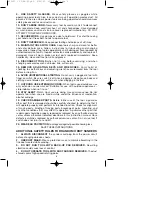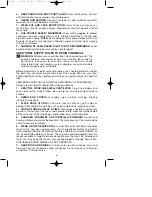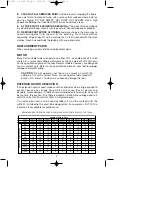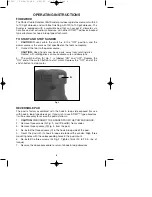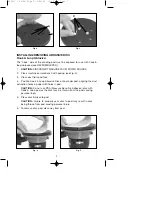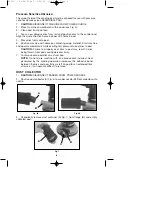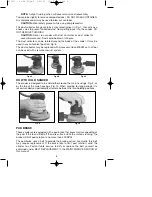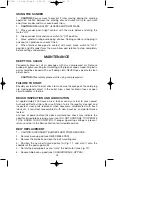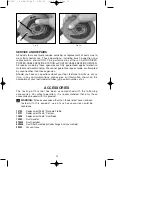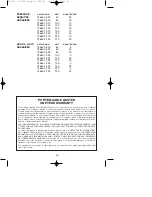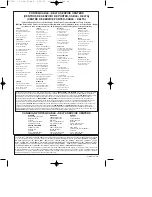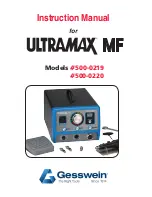
3
9.
USE SAFETY GLASSES.
Wear safety glasses or goggles while
operating power tools. Also face or dust mask if operation creates dust. All
persons in the area where power tools are being operated should also wear
safety glasses and face or dust mask.
10. DON’T ABUSE CORD.
Never carry tool by cord or yank it to disconnect
from receptacle. Keep cord from heat, oil, and sharp edges. Have damaged
or worn power cord and strain reliever replaced immediately. DO NOT
ATTEMPT TO REPAIR POWER CORD.
11. SECURE WORK.
Use clamps or a vise to hold work. It’s safer than using
your hand and it frees both hands to operate tool.
12. DON’T OVERREACH.
Keep proper footing and balance at all times.
13. MAINTAIN TOOLS WITH CARE.
Keep tools sharp and clean for better
and safer performance. Follow instructions for lubricating and changing
accessories. Inspect tool cords periodically and if damaged, have repaired by
authorized service facility. Inspect extension cords periodically and replace if
damaged. Have all worn, broken or lost parts replaced immediately. Keep
handles dry, clean and free from oil and grease.
14. DISCONNECT TOOLS
when not in use, before servicing, and when
changing accessories such as blades, bits, cutters, etc.
15. REMOVE ADJUSTING KEYS AND WRENCHES.
Form habit of
checking to see that keys and adjusting wrenches are removed from the tool
before turning it on.
16. AVOID UNINTENTIONAL STARTING.
Do not carry a plugged-in tool with
finger on switch. Be sure switch is off when plugging in. Keep hands, body and
clothing clear of blades, bits, cutters, etc. when plugging in the tool.
17. OUTDOOR USE EXTENSION CORDS.
When tool is used outdoors, use
only extension cords marked “Suitable for use with outdoor appliances –
store indoors when not in use.”
18. STAY ALERT.
Watch what you are doing. Use common sense. Do not
operate tool when you are tired or while under the influence of medication,
alcohol or drugs.
19. CHECK DAMAGED PARTS.
Before further use of the tool, a guard or
other part that is damaged should be carefully checked to determine that it
will operate properly and perform its intended function. Check for alignment
of moving parts, binding of moving parts, breakage of parts, mounting, and
any other conditions that may affect its operation. A guard or other part that
is damaged should be properly repaired or replaced by an authorized service
center unless otherwise indicated elsewhere in this instruction manual. Have
defective switches replaced by authorized service center. Do not use tool if
switch does not turn it on and off.
20. WEAR EAR PROTECTION
to safeguard against possible hearing loss.
SAVE THESE INSTRUCTIONS
ADDITIONAL SAFETY RULES FOR RANDOM ORBIT SANDERS
1.
ALWAYS DISCONNECT
the sander cord plug from the power circuit
before changing abrasive sheets.
2.
USE DUST MASK.
Wear a protective mask to minimize breathing in the
fine dust created while sanding.
3.
DO NOT RUN TOOL WITH BACK-UP PAD REMOVED.
Resulting
vibration could cause loss of control.
4.
DO NOT OPERATE TOOL WITH DUST SHROUD REMOVED.
The dust
shroud covers high-speed rotating parts.
900007 - 02-28-01.QXD 9/26/02 11:46 AM Page 3



